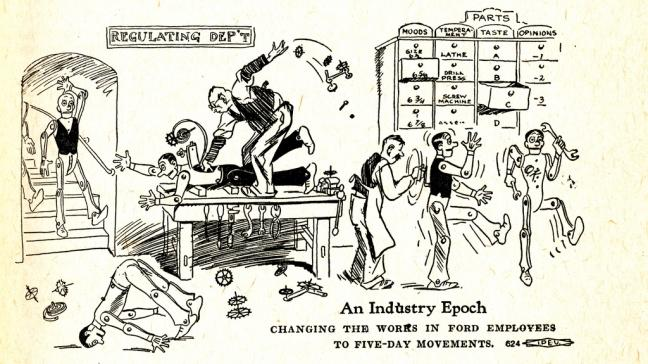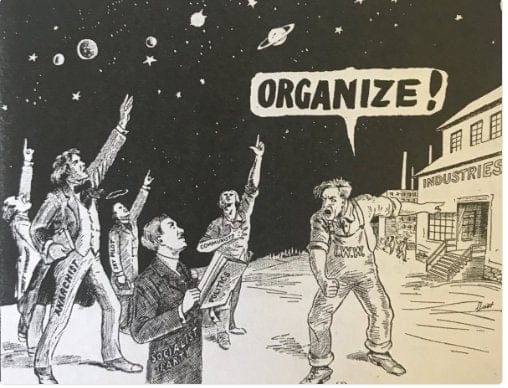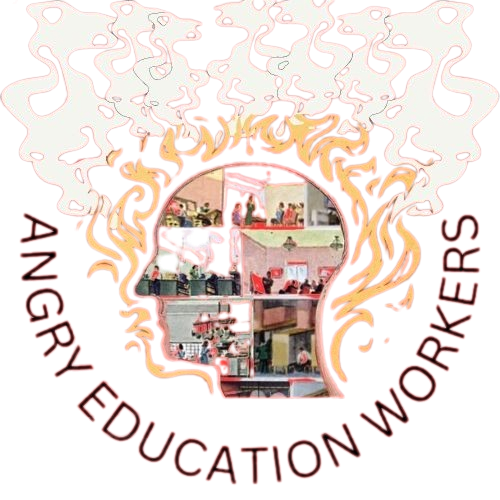Students Belong in the Union!
This essay was adapted from a pamphlet written by UK based members of the Industrial Workers of the World (IWW) union for student-organizers. Given the upsurge in undergraduate student-worker organizing in the last few years, it is an essential development we must analyze.

Students are workers and need a union, too
This essay was adapted from a pamphlet written by UK based members of the Industrial Workers of the World (IWW) union for student-organizers. Given the upsurge in undergraduate student-worker organizing in the last few years, it is an essential development we must analyze. If you are a student-worker at a university or college (or know someone who is), please steal, share, and adapt this text however best suits your specific context. Critiques are also more than welcome!
Paying to be an apprentice
Being a student means building the knowledge and skills you need to enter the workforce in the future. Yet it is the only kind of job you have to pay for. Students attend classes, research, write papers, and take part in extracurricular activities. If they are lucky, students can access a post-secondary education for free, but are still expected to work to cover their living expenses, or go into debt. Students are expected to wring blood from a stone to gain the skills that will benefit their future employer.
A century and more ago, high school and university were bastions of the children of the privileged and rich. Since then, the scale and reach of secondary and post-secondary education has expanded tremendously, with 90 percent of the American population earning a high school degree and anywhere from 25 to 40 percent earning a college degree.
The United States has transitioned to a service and information economy. This has led to all sorts of misunderstandings about the class status of various workers. Restaurant and retail workers, for example, are frequently seen as not being “real workers.” Uber, Doordash, and other gig economy employees are categorized—legally and socially—as independent contractors. Education workers get lumped into this, too, because we don’t technically “produce” something.
But that ignores what has actually happened. The United States didn’t deindustrialize at all. The real story is one of downsizing the manufacturing economy while industrializing other sectors such as education, healthcare, high tech, logistics, retail, and restaurants.
The work students do is just that: work. Traveling to the library, reading books, typing essays, collecting samples for labs, presenting data, shaping sculptures, rehearsing for performances—all for a grade—takes time, energy, and concentration. It’s labor. On top of that, their own schools are usually more than happy to exploit their students' labor in cafeterias, offices, and on facility grounds whenever they can. If you are reading this, there is a high likelihood you work for the university you attend. Or work nearby, with the university buoying the entire economic landscape that surrounds you.
While students are expected to pay to gain the knowledge and skills they need, or do it for free, trade workers take on paid apprenticeships to do the same thing. How did we get to this stage where the work of those studying for a trade is seen as worthy of compensation, and the work done by students in purely academic tracks is seen as a privilege?

The lie of manual versus skilled labor
The onset of industrialization and factory work saw the division of workers into two types. This division of labor, later formalized through the ‘scientific management’ theory established by Fred Taylor, separated those who managed the work, from those who would do the work itself. Work planners were seen as scientists breaking down tasks to maximize productivity and output. Those doing the work were seen as easily replaceable low skilled machines.
The technical composition of the working class (the division of labor) is vastly different than what it was at the onset of industrialization, but its objective remains the same: create a hierarchy between workers to maximize output and minimize costs—especially labor costs. Bosses and the press can arbitrarily label sets of workers as “unskilled” and cast the work they do as useless even though it has critical social value. This justifies poverty wages, racism, and criminalization of a “lower class”.
White collar work, on the other hand, is presented as superior, even though the same fundamental boss-worker relationship still exists. For a shrinking percentage of white collar workers who make it to the managerial class, there really is dignity and ease in working. This hierarchy is used to present studying as a privilege worth paying for. But for a growing number, the list of items that distinguishes their conditions from those of blue collar workers gets shorter by the day. Even those who luck out and “make it” to a middle income lifestyle are discovering that their conditions are deteriorating rapidly, or were garbage to begin with. Nurses and teachers, for example. Or office workers now contending with bosses over returning to in-person work.
The historical structure of the education industry laid the foundation for a division of labor between workers: one where teachers work by teaching, and students work by learning—with no input and no authority to question what they are teaching or being taught. We believe that these divisions of labor between instructional staff and students are as arbitrary as the ones between blue collar and white collar workers. But beliefs are useless without theory and action to back them up. How did students end up cast as no more than mere raw materials? To answer that question, we need to analyze the shape of the education industry.
The education industry includes: public, charter, and private pre-Kindergarten through 12th grade schools; post-secondary institutions like colleges, universities, and trade schools; non-profits, foundations, and government departments geared towards education research, funding, and curriculum development; corporate and government job training and lifelong learning facilities; cultural institutions like museums and libraries; and the amorphous armies of gig tutors and tutoring companies that surround the entire industry.
Since the 1840s, and especially since the 1890s, education industrialized from local, community-based schools to an industry in the same way the retail, service, logistics, legal, healthcare, hospitality, railroad, construction, maritime, and agricultural industries did. Under the guise of ‘reform,’ these succeeding generations of ruling class capitalists have shaped and reshaped education along industrial lines. Since 1992, and especially since 2001, capitalists have peeled away huge swathes of education from the public sector entirely through charter schools and vouchers. This rapidly accelerated the pace of industrialization as administrators and corporate executives were able to dodge unions and public accountability. Unionized education workers, including students, face constant attacks largely because they explode the line dividing “middle class” “from working class” for what it is: almost entirely ideological rather than material.
Education workers sometimes carry out the production in the industry, such as lesson planning, studying, exhibit construction, essay writing, classroom setup, program creation, experiment setup, or teaching. Other times, these workers distribute products or implement tools already generated by the managerial class and produced by workers in other industries as a service. Textbooks from the printing and publishing industry, for example. Then, there are education ‘non-profits’ like Great Minds, which originally created the Common Core curriculum. Workers with cushy jobs develop the curriculum tools teachers and other education workers use to shape the raw material—students—into the workers, managers, and owners of the future.
Teachers, on the other hand, are presented as professionals with autonomy to teach essential information in creative ways. Even if the reality is that the teacher is implementing an increasingly scripted curriculum crafted by administrators and researchers working at corporate curriculum mills. These folks in the professional managerial class have rarely taught or learned in the same environments their curriculum will be implemented in Yet, they see teachers, students, and other education workers as below them. Division of labor always seems to come with deskilling as workers complete smaller and smaller tasks. This justifies stagnant or declining pay and conditions for education workers of all kinds.
And since 2008, hordes of college students are stuck busting their asses at low wage jobs for at least a few years after leaving school. Every year since the Great Recession, the percentage is somewhere between 30 and 50 percent. Since the pandemic that shot up even more. So what’s all this student debt for? What’s all that work you’re putting into your studies for? You were told it was to get a good job. But even the “good jobs” are getting less good by the day. All around us, the standards are shooting up at an exponential rate. Forty years ago, you could land a job that didn’t pay terribly whether or not you had a college degree. Now, after decades of Neoliberalism, the current system is dysfunctional—education costs have skyrocketed while the value of a degree has plummeted.
The shiny information economy of the future is actually a dystopian nightmare. It’s a beautiful university or college campus in a beautiful city skyline held up by an ecosystem characterized by exploitation. Let’s take a short tour. In the library you’ll find sleep deprived student-workers, stressed out librarians, even more sleep deprived students churning out term papers, and immigrant workers contracted from a cleaning service scrubbing the bathrooms. Some of these workers have been forced to work while pregnant, causing them to miscarry.
Take a peek inside the classrooms, where scandalously underpaid adjuncts, student researchers, and graduate workers teach class after class and walk away with a stack of papers to grade in a shitty apartment that takes up most of their meager incomes. All this in the vain hope of a tenure track faculty position.
Meanwhile, students rush to keep up with the workload demanded by the university administrators. You stay up all night, again, to complete that term paper after your work shift at the college's payroll department where you alphabetized thousands of tax forms for minimum wage. You pick up the slack your lab-mate just won’t help with. You sign up for an extra class so you can possibly graduate early and take on less debt. You haggle with the financial aid office for just a little more to help you out. You watch your credit score tank as the debt just keeps piling up anyways. You go through another day slogging through classes, then a work shift as a part-time groundskeeper, or researcher, or university phone-banker, or restaurant waiter, or factory worker, or whatever else. All to keep the lights on in a shitty one bedroom apartment you share with a rotating cast of roommates. All for the chance to receive a piece of paper that may or may not get you a job.
Outside, facilities workers keep up the campus grounds amid soaring temperatures. Back inside, custodial and food service staff are sub-contracted out to companies like Aramark to divide them from their fellow education workers at the same schools. Mainstream union leaderships often uphold this division, separating workers at the same institution into different bargaining units that compete for measly benefits and fail to support each other during labor actions.
Students do much of the essential work that keeps a post-secondary institution running. Without the flow of papers, tests, and other materials to be evaluated, a large part of the instructional staff would have no jobs at all. During our time as students, we’re basically cast as raw materials—even though we’re actually working. Frequently, we spend time working for the institutions we studied at. Many of those same custodial, grounds-keeping, and food service jobs are also staffed by students. That work builds the schools and maintains them. Instead of just being molded at institutions, students should organize and direct their own educational labor!

Where are the student unions?
Just like labor unions, student unions were meant to break that hierarchy and give students negotiating power over the curriculum and how university resources are spent. Instead, student unions have become student governments beholden to universities who control their income, limit their scope, and channel attempts at real change into bureaucratic processes skewed in favor of university management.
Student governments are now seen as nothing more than service providers organizing social events, running bars with cheap alcohol, and enhancing the “student experience”. Meanwhile, fundamental problems caused by university management such as skyrocketing tuition, less contact time, and worsening mental health get little attention.
Staff working conditions are student learning conditions. Pay and pension cuts, increased workloads and casualization, and widespread depression has seen poor working conditions directly translate into a poorer quality of education.
True undergraduate worker unions that serve as a vehicle for building militant solidarity and power among the student body are emerging. To name just one example, undergraduate student-workers at Temple University in Philadelphia have been organizing since September 2022. These unions, rooted in the productive fabric of the higher-education sector of the industry, have the potential to build real power among students as workers, rather than as amateur bourgeois politicians.
But they are still rare. There are unique, challenging obstacles that students have to face as they try and organize. Students usually single-mindedly point themselves towards their classes and paying their bills—leaving little time for organizing that could get them in trouble or knock their studies off course. Dizzying levels of student loan debt and a decayed social safety net leave students in precarious situations where their choices are between ruining their finances to get a degree or returning home to often abusive families. Deaths of despair and soaring homelessness rates among those without any post-secondary education or training serve as an extra stick to keep students churning out work.
For these students, just getting to their graduation date and getting some type of decent job are the overwhelming priorities. Being a student means undergoing a process of transformation that can lead you into specific professions. Some of these are still high paying, good quality jobs. Engineering and other STEM degrees, for example, are still highly prized by employers. Master’s degrees unlock higher positions and pay. Medical and law school degrees almost guarantee entry to the petit-bourgeoisie. Degrees in education and nursing don’t bring great pay or working conditions—but you will have a job (because no one else wants to do this shit).
If you can run the gauntlet.
On their way towards that shiny mirage, around 40 percent of college students drop out. Overwhelming academic pressures and financial pressure are the overwhelming reasons why. Countless students have scholarships and financial aid directly tied to their GPA. This keeps students competing with each other for the highest GPA, the most extracurriculars, the fanciest internships. Students can constantly be heard bragging about how little they sleep and how burnt out they are.
These students are often from wealthy backgrounds. They don’t worry about material survival like most other students have to. So they can rep the ‘grindset’ and reinforce a culture of exploitation with a smile. The system hurts these students, too, but they can tough it out until their parents land them a cushy job.
Existing student unions are dominated by these privileged students. They have the time, energy, and resources to invest to thoroughly participate. The problem, of course, is that they’re interested in ingratiating themselves to administration. Respectable chats are the way they solve their problems.
We need a different way.
Refuse to be divided
Despite the common struggles faced by students, professors, and other university staff, students are still seen as something separate from staff unions. This has allowed university management to endlessly play divide and conquer.
Many students have seen through this lie. Students have independently organized sit-ins, occupations, and protests in support of their staff. For example, hundreds of freshmen at American University walked out of opening ceremonies and joined staff on the picket line in August 2022. Administration’s will was already crumbling from the militancy of the strikers. With the university refusing to bargain, these workers had voted to authorize a strike from August 22-26—right during student move in. University administration first tried to turn the student body against the workers, then otherwise ignored them. That was an abject failure as workers loudly marched around the entire campus. Many of these workers were also students themselves, making it easy to maintain the support of the undergraduates.
Then, administration tried to break the strike by forcing some of the custodial staff to begin moving students’ belongings and furniture into the dorms. Workers and students shut this down and shamed the university publicly. Local city politicians and media outlets spread the story and even offered support to the workers. When the university held its opening ceremony on the final day of the strike, students walked out, chanting “pay your workers!”. After the student walkout, administration accepted defeat and returned to the bargaining table with major concessions, and the workers—affiliated with Local 500 of the SEIU—celebrated a stunning victory.
The Industrial Workers of the World (IWW) wants to break this divide. We organize all workers employed by post-secondary schools—including students—into independent committees. These committees use direct democracy and direct action to identify common issues and find ways to fight back together.
We believe that knowledge is a social good and should be freely and readily accessible and available to all. We believe that those engaged in educational work—teachers and students—should be determining what is being taught and how. This can only be achieved once we abolish capitalist society.

You can find the original UK IWW student pamphlet here:

